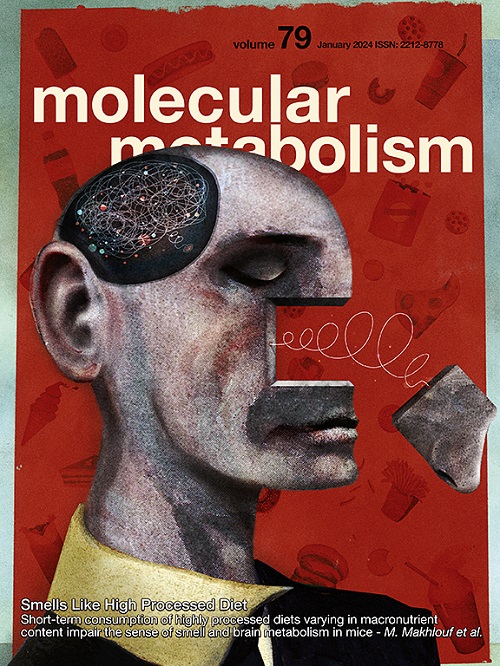小胶质内质网应激反应通过IRE1α调节饮食诱导的代谢失衡和小鼠肥胖。
IF 6.6
2区 医学
Q1 ENDOCRINOLOGY & METABOLISM
引用次数: 0
摘要
背景:慢性高脂肪饮食(HFD)喂养会引发下丘脑炎症和与内质网(ER)应激相关的全身代谢功能障碍。胶质细胞,特别是小胶质细胞和星形胶质细胞,是下丘脑炎症的中枢介质。然而,肌醇要求酶1α (IRE1α)在神经胶质细胞中的作用及其对代谢功能障碍的贡献仍然是未知的。目的:探讨小胶质细胞IRE1α在hfd诱导的代谢功能障碍中的作用。方法:利用新型条件敲除小鼠模型(CX3CR1GFPΔIRE1和TMEM119ERΔIRE1),我们在免疫细胞中或只在小胶质细胞中敲除IRE1α,研究其对饲喂HFD 16周小鼠代谢健康和下丘脑转录变化的影响。结果:在体外实验中,在小胶质细胞中删除IRE1α可显著降低lps诱导的促炎细胞因子基因表达。小胶质细胞中的IRE1α缺失保护雄性小鼠免受hfd诱导的肥胖、葡萄糖耐受不良和下丘脑炎症的影响,而在雌性小鼠中没有观察到代谢益处。rna测序揭示了下丘脑显著的转录重编程,包括与线粒体脂肪酸氧化、代谢适应性和抗炎反应相关的基因上调。结论:我们的研究结果表明,ire1 α-介导的小胶质内质网应激反应显著促进了HFD对下丘脑炎症和全身代谢功能障碍的反应,特别是在男性中,证明了小胶质内质网应激反应在饮食性肥胖和代谢性疾病中的重要作用。本文章由计算机程序翻译,如有差异,请以英文原文为准。

Microglial ER stress response via IRE1α regulates diet-induced metabolic imbalance and obesity in mice
Background
Chronic high-fat diet (HFD) feeding triggers hypothalamic inflammation and systemic metabolic dysfunction associated with endoplasmic reticulum (ER) stress. Glial cells, specifically microglia and astrocytes, are central mediators of hypothalamic inflammation. However, the role of Inositol-Requiring Enzyme 1α (IRE1α), a primary ER stress sensor, in glial cells and its contributions to metabolic dysfunction remains elusive.
Objectives
To investigate the role of IRE1α in microglia in mediating HFD-induced metabolic dysfunction.
Methods
Using novel conditional knockout mouse models (CX3CR1GFPΔIRE1 and TMEM119ERΔIRE1), we deleted IRE1α in immune cells or exclusively in microglia and studied its impact on metabolic health and hypothalamic transcriptional changes in mice fed with HFD for 16 weeks.
Results
Deleting IRE1α in microglia significantly reduced LPS-induced pro-inflammatory cytokine gene expression in vitro. IRE1α deletion in microglia protected male mice from HFD-induced obesity, glucose intolerance, and hypothalamic inflammation, with no metabolic benefits observed in female mice. RNA-sequencing revealed significant transcriptional reprogramming of the hypothalamus, including upregulation of genes related to mitochondrial fatty acid oxidation, metabolic adaptability, and anti-inflammatory responses.
Conclusions
Our findings reveal that IRE1α-mediated ER stress response in microglia significantly contributes to hypothalamic inflammation and systemic metabolic dysfunction in response to HFD, particularly in males, demonstrating an important role of microglial ER stress response in diet-induced obesity and metabolic diseases.
求助全文
通过发布文献求助,成功后即可免费获取论文全文。
去求助
来源期刊

Molecular Metabolism
ENDOCRINOLOGY & METABOLISM-
CiteScore
14.50
自引率
2.50%
发文量
219
审稿时长
43 days
期刊介绍:
Molecular Metabolism is a leading journal dedicated to sharing groundbreaking discoveries in the field of energy homeostasis and the underlying factors of metabolic disorders. These disorders include obesity, diabetes, cardiovascular disease, and cancer. Our journal focuses on publishing research driven by hypotheses and conducted to the highest standards, aiming to provide a mechanistic understanding of energy homeostasis-related behavior, physiology, and dysfunction.
We promote interdisciplinary science, covering a broad range of approaches from molecules to humans throughout the lifespan. Our goal is to contribute to transformative research in metabolism, which has the potential to revolutionize the field. By enabling progress in the prognosis, prevention, and ultimately the cure of metabolic disorders and their long-term complications, our journal seeks to better the future of health and well-being.
 求助内容:
求助内容: 应助结果提醒方式:
应助结果提醒方式:


